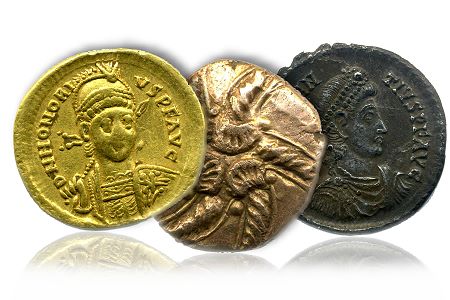June 24, 2012
Roman silver miliarensis came third
in Nation’s Greatest Find contest
A Roman silver coin dug from a field in Bedfordshire by an
amateur metal detectorist which went on to be placed third in The
Nation’s Greatest Find 2010 competition is one of the star lots in a
London auction of ancient and world coins and medals.
 The
coin, a silver miliarensis from the reign of the Roman emperor
Constantius II (AD 337-361 – he was one of the sons of Constantine the
Great) is expected to sell for £600-800 in the auction, which is
organised by specialist auctioneers Morton & Eden in association
with Sotheby’s.
The
coin, a silver miliarensis from the reign of the Roman emperor
Constantius II (AD 337-361 – he was one of the sons of Constantine the
Great) is expected to sell for £600-800 in the auction, which is
organised by specialist auctioneers Morton & Eden in association
with Sotheby’s.
“It is a most beautiful coin,” said the man who found it,
who asked not to be named. “I’ve been metal detecting for about 10 years
and it’s among the best things I’ve ever found. Despite its age, it was
in remarkably good condition and none the worse for being in the ground
for so long. When I heard about the competition, I had no hesitation in
entering it and I was thrilled when it came third.”
The competition, which took place at the government’s Department of Portable Antiquities and Treasure, is organised annually by The Searcher, a specialist magazine for detectorists and treasure hunters. Culture Minister Ed Vaizey paid a visit during the judging.
Writing about the competition in the magazine, Peter
Spencer, one of the judges said picking out the three winners in the
coin category was a lengthy procedure because all the judges had
different favourites. He said: “From the start I had pointed out the
merit of the miliarense. It is in really good condition and is a very
rare denomination for Constantius II. It was placed in third position.”
Discovered on the same secret Bedfordshire site was a gold solidus from the reign of the emperor Honorius (AD 393-423), a weak ruler whose empire moved towards collapse. The Constantinople-minted coin depicts him helmeted with spear and shield, while the reverse shows Constantinopolis seated, holding a spear and a small figure of Victory on a globe. The coin is estimated at £300-350.
A gold stater from the reign of the late Iron Age Celtic ruler Addedomaros (c. 45-25 B.C.) found on the same site by another detectorist is estimated at £700-900. It was minted by the Catuvellauni, a Celtic tribe in South-East England covering what is now Essex and part of Suffolk. The coin bears a six-arm spiral ornament on the obverse and a Celtic horse on the reverse.
All three coins were reported to the Portable Antiquities Scheme, as required by law, and the money raised by their sale will be divided between the respective finders and the landowner.
They will be sold in a two-day auction of Ancient, Islamic, British and World Coins and Medals, held at Sotheby’s, on Tuesday and Wednesday July 3-4 and on public view at 45 Maddox Street W1 on Thursday June 28, Friday June 29 and Monday July 2 from 10am-4.30pm or by previous arrangement.
For further information, please contact Tom Eden on 0207 493 5344 or info@mortonandeden.com.